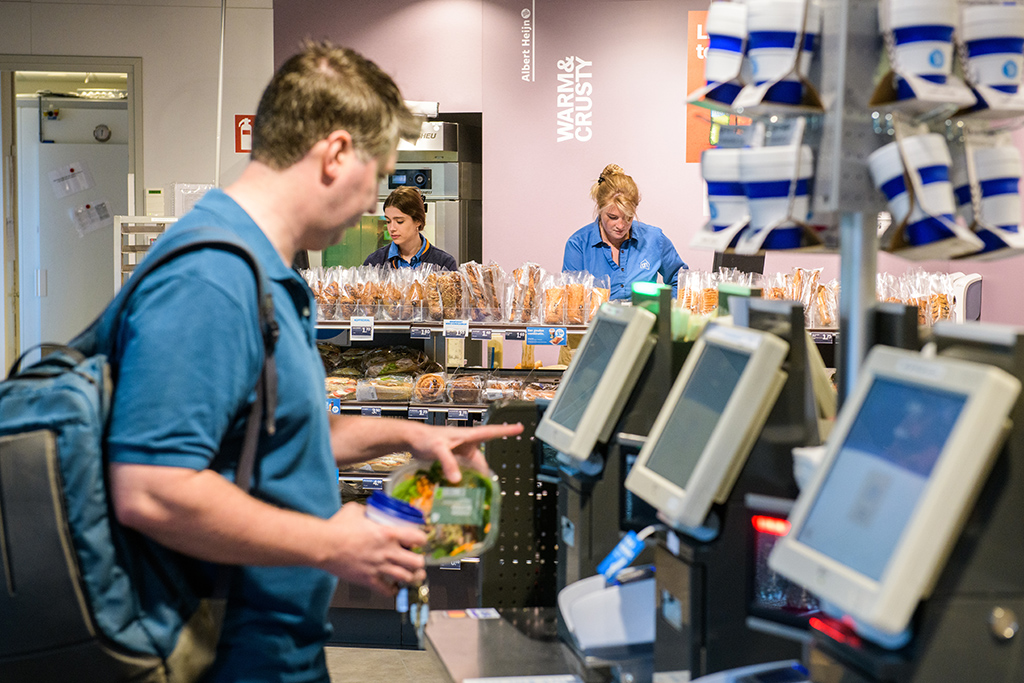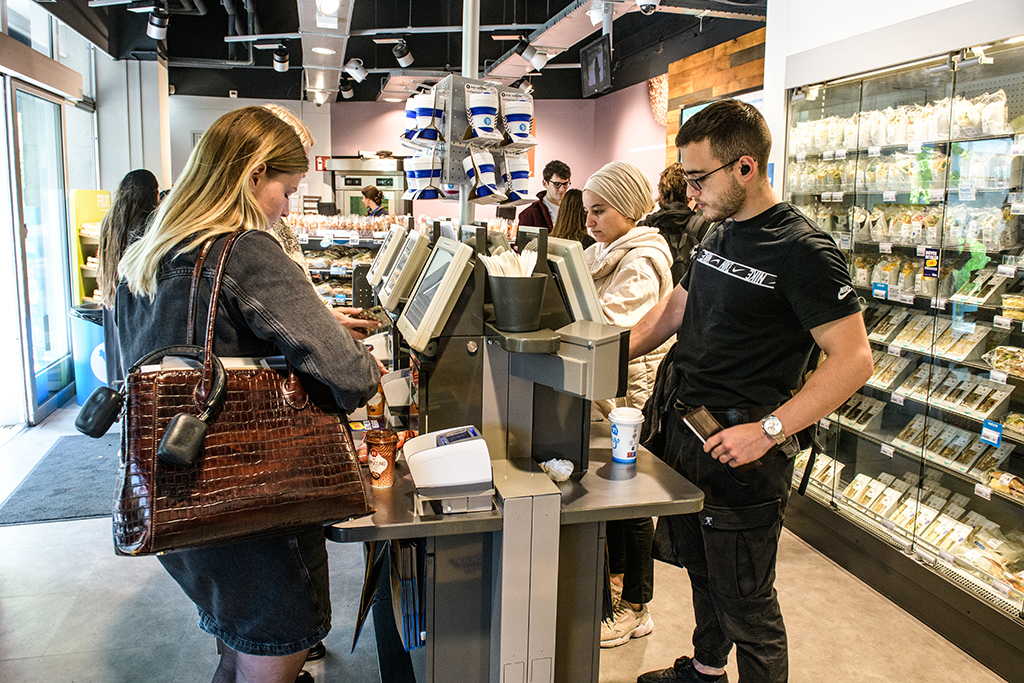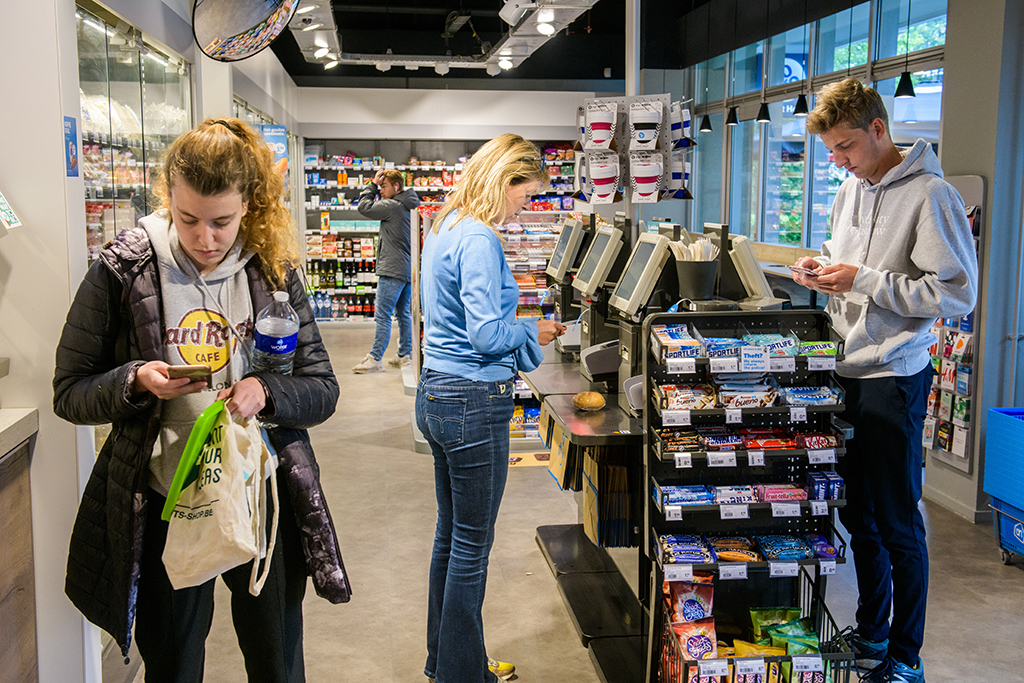Self-checkout makes us live without real contact more often
It seems easy and quick, self-checkout. But it also means that students and staff have little contact with the people behind their coffees and sandwiches at the AH To Go. If you know that the store is set up in such a way that you don’t have to speak to each other, you can of course do so anyway, argues economist Ben Vollaard.

At the AH To Go on campus, you can do it yourself. Take your sandwich from the shelf and operate the coffee machine yourself. You also do the checkout yourself. Contact with the people who run the store is not necessary. It is not necessary, and therefore, it does not happen often. Customers simply continue their conversation, by phone or otherwise. Customers who listen to music continue to do so. The headphones don’t come off, the sound doesn’t go off.
Some customers are so preoccupied with their thoughts or with others that they even forget to pay. When an employee calls them on it, they often say they can’t remember whether they paid or not. “I do believe it sometimes,” says manager Ferry (27). “A lot of customers are so deep in thought, they aren’t in the present.”
A visit can go without a single “good morning” or “goodbye” for Ferry who puts new sandwiches on the shelves, Maaike (28) who refills the milk in the coffee machine, or Imke (20) who restocks the dairy section. “A lot of people don’t greet, you never get used to that,” says Maaike, a warm-hearted Brabant native. “I see them, but they don’t see me.” She notices this most strongly with young customers. “They seem to have already adjusted to it.”
Chat
The impersonal nature of the store is a problem because Maaike started working in retail because of the social aspect: “I like doing something for someone else and having a chat.” She radiates that. “If I can help, I do so gladly.” She immediately jumps up when a customer brings in their own mug of coffee. “Then you get a discount, I’ll make sure of that!”

The concept of the AH To Go on campus fits into a broader trend. Self-checkout is increasingly the norm. Cashiers are becoming checkers. They watch and occasionally check whether a customer has neatly scanned all the items. The reason for this change? Lower labor costs. One employee watches while, for example, five people check out at the same time. That’s cheaper than a cashier who can only serve one customer at a time. In effect, the customer has taken over the cashier’s job.
While in a self-service store there is no more room for personal contact, the employees are still socially minded people. They are not shelf stackers who quietly carry out simple tasks. Manager Ferry has a university of applied sciences degree in his pocket, and he has the final responsibility for the ins and outs of the store, which has weekly turnovers of many tens of thousands of euros. This involves a lot of work, such as hiring and managing staff, ordering products, solving technical problems with equipment, and keeping the financial accounts.
Shelf stacker in the background
Ferry, meanwhile, does many practical things in the store. He is therefore always among the people, but for them he is the shelf stacker who does his work in the background. Nobody addresses a shelf stacker. That is what this store concept evokes; it is not that the customers or Ferry are not social. This situation meets the definition of loneliness well: being surrounded by people with whom you do not feel connected. Ferry has a sufficiently busy personal life not to suffer—he is a semi-pro soccer player in his spare time—but he cannot avoid this in the thirty hours he spends in the store each week. “It’s what it is,” he says, “fortunately there are also people who do know us and greet us.”
For the employees, this store concept is not an improvement, but what about the customer? Self-checkout can mean time savings, although that seems limited to times when it is busy. The number of self-checkout terminals is greater than the number of staffed checkouts. Customers may also share in the benefit of lower labor costs through lower prices.

On the other hand, you become one step further removed from the people who are working for your coffee and sandwich. They live in their world, you live in yours. The self-scanner stands between you and them. This is a development that causes people to live without real contact more often. Just like the public transport pass, electronic banking and, much earlier, the self-service gasoline pump.
People you see every day
The difference is that these are people in your workplace, on campus. People you see every day, maybe several times a day. If you don’t know better, you might not miss the contact. Those who do know better, for example because you know shopkeepers in your own neighborhood, will find it meagre. People are social animals, want to feel connected.
What’s more fun when you get a coffee in the morning, to have a chat with Ferry, for example? Then another world opens up to you as well. Fortunately, there is nothing to stop you. If you know that the store is set up in such a way that you don’t have to speak to each other, then of course you can do that anyway. Maaike greets you anyway, she says. “I have a loud voice, so you can hear me even if you keep your headphones on.”
Ben Vollaard is an associate professor in the Department of Economics (TISEM).
Translated by Language Center, Riet Bettonviel






